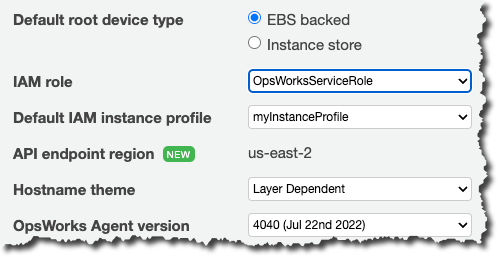Specifying Permissions for Apps Running on EC2 instances
Important
The AWS OpsWorks Stacks service reached end of life on May 26, 2024 and has been disabled for both new and existing customers.
We strongly recommend customers migrate their workloads to other solutions as soon as possible. If you have questions about migration, reach out to the AWS Support Team on AWS re:Post
If the applications running on your stack's Amazon EC2 instances need to access other AWS resources, such as Amazon S3 buckets, they must have appropriate permissions. To confer those permissions, you use an instance profile. You can specify an instance profile for each instance when you create an AWS OpsWorks Stacks stack.

You can also specify a profile for a layer's instances by editing the layer configuration.
The instance profile specifies an IAM role. Applications running on the instance can assume that role to access AWS resources, subject to the permissions that are granted by the role's policy. For more information about how an application assumes a role, see Assuming the Role Using an API Call.
You can create an instance profile in any of the following ways:
-
Use the IAM console or API to create a profile.
For more information, see Roles (Delegation and Federation).
-
Use an AWS CloudFormation template to create a profile.
For some examples of how to include IAM resources in a template, see Identity and Access Management (IAM) Template Snippets.
An instance profile must have a trust relationship and an attached policy that grants permissions to access AWS resources.
{ "Version": "2012-10-17", "Statement": [ { "Sid": "", "Effect": "Allow", "Principal": { "Service": "ec2.amazonaws.com" }, "Action": "sts:AssumeRole" } ] }
The instance profile must have this trust relationship for AWS OpsWorks Stacks to act on your behalf. If you use the default service role, do not modify the trust relationship. If you are creating a custom service role, specify the trust relation ship as follows:
-
If you are using the Create Role wizard in the IAM console
, specify the Amazon EC2 role type under AWS Service Roles on the wizard's second page. -
If you are using a AWS CloudFormation template, you can add something like the following to your template's Resources section.
"Resources": { "OpsWorksEC2Role": { "Type": "AWS::IAM::Role", "Properties": { "AssumeRolePolicyDocument": { "Statement": [ { "Effect": "Allow", "Principal": { "Service": [ "ec2.amazonaws.com" ] }, "Action": [ "sts:AssumeRole" ] } ] }, "Path": "/" } }, "RootInstanceProfile": { "Type": "AWS::IAM::InstanceProfile", "Properties": { "Path": "/", "Roles": [ { "Ref": "OpsWorksEC2Role" } ] } } }
When you create your instance profile, you can attach an appropriate policy to the profile's role
at that time. After you have created the stack, you
must use the IAM consoleregion and
DOC-EXAMPLE-BUCKET with values appropriate to your configuration.
{ "Version": "2012-10-17", "Statement": [ { "Effect": "Allow", "Action": "s3:*", "Resource": "arn:aws:s3:region::DOC-EXAMPLE-BUCKET/*" } ] }
For an example of how to create and use an instance profile, see Using an Amazon S3 Bucket.
If your application uses an instance profile to call the AWS OpsWorks Stacks API from an EC2 instance,
the policy must allow the iam:PassRole action in addition to the appropriate
actions for AWS OpsWorks Stacks and other AWS services. The iam:PassRole permission allows
AWS OpsWorks Stacks to assume the service role on your behalf. For more information about the AWS OpsWorks Stacks API,
see AWS OpsWorks API
Reference.
The following is an example of an IAM policy that allows you to call any AWS OpsWorks Stacks action from an EC2 instance, as well as any Amazon EC2 or Amazon S3 action.
{ "Version": "2012-10-17", "Statement": [ { "Effect": "Allow", "Action": [ "ec2:*", "s3:*", "opsworks:*", "iam:PassRole" ], "Resource": "arn:aws:ec2:region:account_id:instance/*", "Condition": { "StringEquals": { "iam:PassedToService": "opsworks.amazonaws.com" } } } ] }
Note
If you do not allow iam:PassRole, any attempt to call an AWS OpsWorks Stacks action
fails with an error like the following:
User: arn:aws:sts::123456789012:federated-user/Bob is not authorized to perform: iam:PassRole on resource: arn:aws:sts::123456789012:role/OpsWorksStackIamRole
For more information about using roles on an EC2 instance for permissions, see Granting Applications that Run on Amazon EC2 Instances Access to AWS Resources in the AWS Identity and Access Management User Guide.